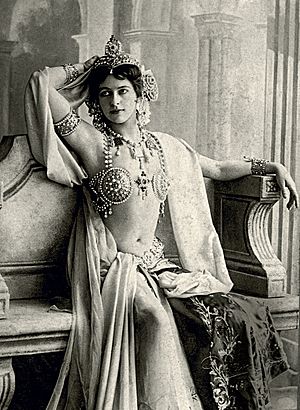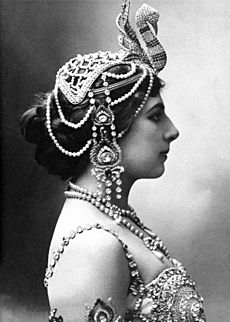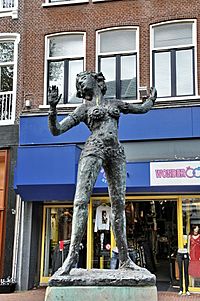Mata Hari facts for kids
Quick facts for kids Mata Hari |
|
|---|---|

Mata Hari circa 1910
|
|
| Allegiance | France, Germany |
| Service | Deuxième Bureau |
| Active | 1916–1917 |
|
|
|
| Birth name | Margaretha Geertruida Zelle |
| Born | 7 August 1876 Leeuwarden, Netherlands |
| Died | 15 October 1917 (aged 41) Vincennes, French Third Republic |
| Cause of death |
Execution by firing squad |
| Nationality | Dutch |
| Parents | Adam Zelle (father) Antje van der Meulen (mother) |
| Spouse |
Rudolf John MacLeod
(m. 1895; div. 1906) |
| Children | 2 |
| Occupation | Exotic dancer |
| Signature | |
Mata Hari was the stage name for Margaretha Geertruida Zelle. She was born in the Netherlands on August 7, 1876. She died in France on October 15, 1917.
Mata Hari became famous as a dancer. Later, she was accused of being a spy during World War I. Her secret files were made public in 2017, one hundred years after she died.
Contents
Early Life of Margaretha Zelle
Margaretha Geertruida Zelle was born on August 7, 1876, in Leeuwarden, Netherlands. She was the oldest of four children. Her parents were Antje van der Meulen and Adam Zelle. She had three younger brothers. Her family lovingly called her "M'greet".
Some people thought Mata Hari had Jewish or Asian family roots. However, experts have found that both of her parents were Dutch. Her father owned a hat shop. He also invested in the oil business. This made his family wealthy.
Margaretha and her siblings enjoyed a rich childhood. They went to special schools until she was 13. In 1889, her father lost his money. Soon after, her parents divorced. Her mother died in 1891.
Her father remarried in 1893. Margaretha then went to live with her godfather. She began studying to be a kindergarten teacher. But after a few months, she left and moved in with her uncle.
Life in the Dutch East Indies
When Margaretha was 18, she saw an advertisement in a Dutch newspaper. A Dutch Colonial Army Captain named Rudolf MacLeod was looking for a wife. He lived in the Dutch East Indies, which is now Indonesia.
Margaretha married Rudolf in Amsterdam on July 11, 1895. This marriage helped her join the Dutch upper class. It also made her financial situation stable. She moved with her husband to Java in May 1897.
They had two children together. Their son, Norman-John, was born in 1897. Their daughter, Louise Jeanne, was born in 1898.
Margaretha's marriage was not happy. She left her husband for a short time. She lived with another Dutch officer. During this time, she learned a lot about Indonesian culture. She also joined a local dance group.
In 1897, she wrote to her family in the Netherlands. She shared her new artistic name, Mata Hari. This means "sun" in the Malay language. It literally translates to "eye of the day".
Margaretha returned to Rudolf at his request. In 1899, both of their children became very sick. Jeanne survived, but Norman died. Some people believe that one of Rudolf's enemies may have poisoned their food.
After returning to the Netherlands, Margaretha and Rudolf separated in 1902. Their divorce was finalized in 1906. Margaretha was given custody of Jeanne. Rudolf was supposed to pay child support, but he never did. One time, when Jeanne visited Rudolf, he did not send her back to her mother. Margaretha could not afford to fight this. Jeanne later died at age 21.
Mata Hari's Career
In 1903, Margaretha moved to Paris, France. She performed as a circus horse rider. She used the name Lady MacLeod. The MacLeod family in the Netherlands did not approve of this. She struggled to make money. She also worked as an artist's model.
By 1904, Mata Hari became a very popular dancer. She was known for her unique style. She performed at the same time as other famous dancers like Isadora Duncan. These dancers were part of the early modern dance movement. They often found inspiration from Asian and Egyptian cultures. Gabriel Astruc became her agent.
Around 1910, many other dancers started to copy her style. Mata Hari's career began to slow down after 1912. Her last public performance was on March 13, 1915.
Trial and Death
On February 13, 1917, Mata Hari was arrested in Paris. She was staying at the Hotel Elysée Palace. She was put on trial on July 24. She was accused of being a spy for Germany. The accusation claimed she caused the deaths of at least 50,000 soldiers.
French and British intelligence thought she was spying for Germany. However, they could not find clear proof against her. Zelle wrote letters to the Dutch Ambassador in Paris. She said she was innocent.
She wrote, "My international connections are due to my work as a dancer, nothing else. Because I really did not spy, it is terrible that I cannot defend myself." At her trial, Zelle strongly said she supported the Allies. She declared her deep love for France, her adopted home.
Mata Hari was executed by a firing squad. Twelve French soldiers carried out the execution. This happened just before dawn on October 15, 1917.
Legacy
Museum Exhibition
The Fries Museum in Leeuwarden, Netherlands, has a "Mata Hari Room". This exhibit includes two of her personal scrapbooks. It also has an oriental rug with the footsteps of her fan dance. The museum is in Mata Hari's hometown. It is known for studying her life and career.
The largest exhibition about Mata Hari opened at the Museum of Friesland. This happened on October 14, 2017. It was one hundred years after her death.
Mata Hari's birthplace is at Kelders 33. The building was damaged by fire in 2013. But it was later restored. An architect studied old drawings of the storefront. He rebuilt it to look like it did when Adam Zelle, Mata Hari's father, had his hat shop there. In 2016, an information center was created in the building. It displays items related to Mata Hari.
Images for kids
-
Mata Hari became known as a femme fatale during World War I.
-
Scrapbook of Mata Hari in the Frisian Museum in Leeuwarden, Netherlands
See also
 In Spanish: Mata Hari para niños
In Spanish: Mata Hari para niños













